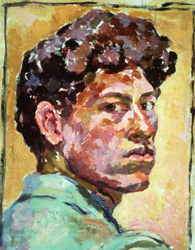Famous for his sculptures of stick-thin figures with razor-sharp, fine features, Alberto Giacometti was an artist who defied categorization. His work flirted with nearly every major art movement of the 20th century, and eventually evolved into a style that was uniquely his own.
Alberto Giacometti Early Days
Alberto Giacometti was born on October 10, 1901, into an artistic family that included his father Giovanni Giacometti, a famous Post-Impressionist painter, godfather Cuno Amiet, a well-known Fauvist painter of the time, and a second cousin, Augusto Giacometti, influential in the Symbolist painting movement.
It’s not surprising that Giacometti exhibited an early inclination toward art. “As a child, what I most wanted to do was illustrate stories,” Giacometti said. “The first drawing I remember was an illustration to a fairy-tale: Snow White in a tiny coffin, and the dwarfs.”
By the time he was 12, Giacometti was in his father’s studio creating oil paintings. At his secondary school in Schiers, Switzerland, he was given a small studio in which he continued to paint and sculpt. He then studied under a pointillist at Geneva’s School of Arts and Crafts and apprenticed with sculptor Maurice Sarkissoff. By the time he was 24, he set up a studio with his brother Diego and began to attract notice in the art world.
Sources in this Story
- Artchive: Alberto Giacometti
- Museum of Modern Art: Exhibitions: Alberto Giacometti
- Art in the Picture: Alberto Giacometti
- The Guardian: ‘My life is reduced to nothing’
- Art Theory: Jean Paul Sartre on Alberto Giacometti: The search for the absolute
- ARTNews: The Giacometti Legacy: A Struggle for Control
Giacometti’s Notable Accomplishments
Giacometti created his first major sculpture, “Spoon Woman,” in 1926. It was shown in a Paris gallery and subsequent sculptures sold quickly. He signed a contract with the Surrealist artists’ preferred dealer and was soon was associating with the avant-garde on a regular basis.
In May 1932, Pablo Picasso was one of the first visitors to Giacometti’s first solo show. Several art magazines covered the show, including one that featured photographs of his work by Man Ray. Although Giacometti’s work eventually set a standard for surrealist sculpture, his technique began to diverge from those of the group.
After his father’s death in 1933, Giacometti started working with models and to sculpt more realistic figures. Seeing this as a betrayal, a group of surrealists asked him to an apartment where they planned to hold a hearing about his presence in the movement. Sensing their intention, he turned on his heel and left.
In the next decade, Giacometti began to develop the style that made him famous. He said he was trying to sculpt realistic figures, but every time he was left with the tall, thin, haunting shapes.
“What I know, more than ever, is that the more I take away, the fatter it becomes,” he said. “But why, I don’t know yet. With the bust I’m doing now, I do nothing but take away, and it’s so fat that I feel it must be twice as thick as it is. So, I’ve got to take away, take away, take away…”
His inability to create exactly what he wanted caused Giacometti great stress. He spent many hours dissecting his feelings with existential philosopher Jean-Paul Sartre. As a result of this friendship, Giacometti’s art became very strongly associated with the existentialist movement.
Alberto Giacometti and his Work
- “Giacometti: A Biography” by James Lord
- “A Giacometti Portrait” by James Lord
- “Alberto Giacometti: A Biography of His Work” by Yves Bonnefoy
- “Alberto Giacometti: Works, Writings, Interviews” by Angel Gonzalez
- “Alberto Giacometti: Sculpture, Painting, Drawings” by Angela Schneider
The Rest of the Story
Near the end of his life, Giacometti began to paint realistic portraits. Sitting for these was a days-long process and the memories of some of his models have been captured in the book “A Giacometti Portrait,” by James Lord. Also during this time, Giacometti explored other enterprises, such as set design; when Samuel Beckett wanted stage dressing for “Waiting for Godot,” Giacometti furnished him with a single barren tree.
Giacometti’s final years were spent in ill health. He continued to sculpt as long as he was able. On January 11, 1966, he died from heart disease.
Unfortunately, he left no will. His widow Annette worked to set up a foundation to preserve his collection before her death in 1993; it was eventually established in 2003, and as of 2006, is represented by the Gagosian Gallery. Prior to that point, there were several legal battles regarding his estate.
This article was originally written by Jennifer Ferris; it was updated October 15, 2017.











